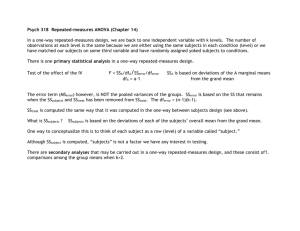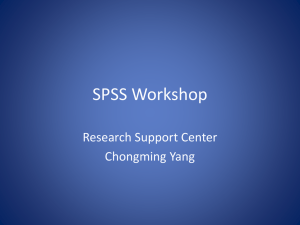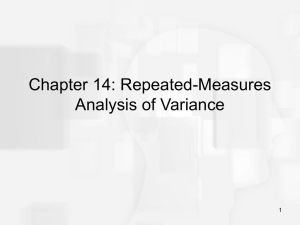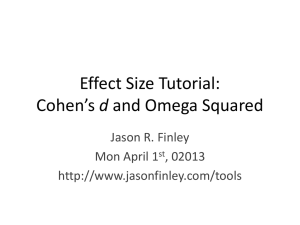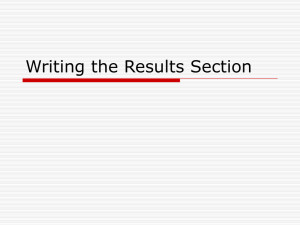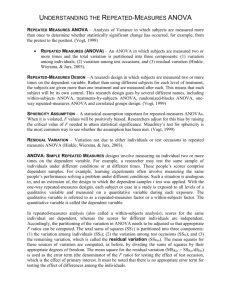Chapter 12: Estimation
advertisement
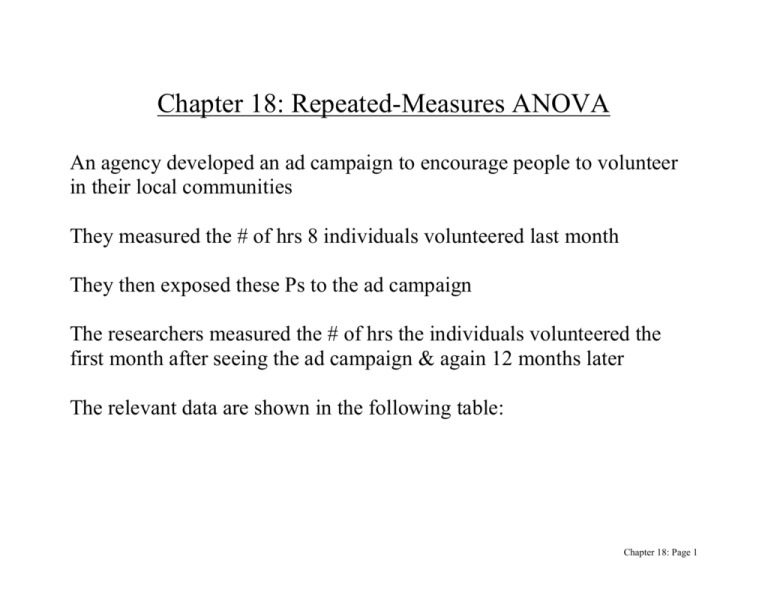
Chapter 18: Repeated-Measures ANOVA An agency developed an ad campaign to encourage people to volunteer in their local communities They measured the # of hrs 8 individuals volunteered last month They then exposed these Ps to the ad campaign The researchers measured the # of hrs the individuals volunteered the first month after seeing the ad campaign & again 12 months later The relevant data are shown in the following table: Chapter 18: Page 1 Month before Ads Month after Ads One-year after Ads 2 3 1 0 0 1 5 3 10 7 4 3 2 4 12 8 5 4 3 2 1 3 10 8 This design allows us to see if the ad campaign changed people’s rates of volunteerism But it also allows us to see if those changes persist over time A repeated-measures ANOVA is the correct statistical procedure: Used when the same Ps are measured 3+ times on the same DV Chapter 18: Page 2 Research Design 1. Between-subjects designs: Different participants serve in each treatment condition Procedures used: independent samples t-test, 1-way anova, 2-way anova 2. Within-subjects (repeated-measures) designs: the same participants serve in each treatment condition Procedures used: related-samples t, repeated-measures ANOVA 3. Mixed designs: the same participants serve in all levels of one IV, but different participants serve in the levels of another IV Procedures used: “mixed” model ANOVA In this lecture, we will focus on within-subjects (repeated-measures) designs Chapter 18: Page 3 Month before Ads Month after Ads One-year after Ads 2 3 1 0 0 1 5 3 10 7 4 3 2 4 12 8 5 4 3 2 1 3 10 8 Notice that there is a great deal of variability in these scores Some from the different measurement times (before, 1-month or 1-year after) Some from individual differences Some people seem to like to volunteer more than others Chapter 18: Page 4 In a between-subjects design, the person-to-person variability (individual differences) contributed to the overall SSTotal But, in a repeated-measures (within-subjects) design, we can remove the personto-person variability from SSTotal and call it the SSSubjects This will reduce the SSError & MSError which makes F-tests of the factors bigger Month before Ads Month after Ads One-year after Ads Subject Mean 2 3 1 0 0 1 5 3 1.875 10 7 4 3 2 4 12 8 6.25 5 4 3 2 1 3 10 8 4.5 5.67 4.67 2.67 1.67 1 2.67 9 6.33 4.21 Chapter 18: Page 5 Sums of Squares Calculations (conceptually): SSTotal = the sum of the squared differences between each score & the overall grand mean SSSubjects = the sum of the squared differences between each “subject mean” & the overall grand mean (multiplied by the number of means comprising each “subject mean”) SSFactor = the sum of the squared differences between each “factor-level mean” & the overall grand mean (multiplied by the number of means comprising each “factor-level mean”) SSError = SSTotal - SSSubjects - SSFactor Chapter 18: Page 6 Degrees of Freedom Calculations: dfSubjects = # of Subjects - 1 dfFactor = k – 1 (where k = the number of “levels”) dfTotal = N – 1 (Where N = the number of responses OR # of Subj X # of levels) dfError = dfTotal - dfSubjects - dfFactor Chapter 18: Page 7 Mean Squares Calculations: MSFactor = SS df Factor Factor MSerror = SS df error error We will not be calculating a MS for subjects b/c we are not interested in it F-Ratio Calculation: F = MSFactor MSerror Chapter 18: Page 8 Summary ANOVA table for repeated-measures: Source Subjects Factor Error Total SS SSS SSF SSE SST df dfS dfF dfE dfT MS F ------ --- MSF MSE F Where: Where: SSS = Sums of Squares for “subjects” SSF = Sums of Squares for the factor (IV) SSE = Sums of Squares error SST = Sums of Squares total dfS = df for subjects dfF = df for factor (IV) dfE = df for error dfT = df total MSF = Mean Squares for the factor (IV) MSE = Mean Squares error F = test statistic to determine if the factor is statistically significant Chapter 18: Page 9 Hypothesis Testing with repeated-measures: (1) Write out the hypotheses: The null hypothesis, as usual, says that there is no effect of our IV (factor). Therefore, all the means will be the same. The alternative hypothesis says that there is some effect of our IV (factor). Therefore, at least two of the means will be significantly different from one another H0: H1: 1 = 2 = ... = K At least two means are significantly different Chapter 18: Page 10 Hypothesis Testing with repeated-measures: (2) Compute a test statistic For repeated-measures, we will find our test statistic either by “filling in” an ANOVA table OR By interpreting SPSS output Let’s practice with the “fill in” procedure now Chapter 18: Page 11 Here is our research situation: We’ve measured the # of hrs 8 individuals volunteered last month We then exposed these Ps to an ad campaign Then we measured the # of hrs the individuals volunteered the first month after seeing the ad campaign & again 12 months later Below is a partially completed anova table: Source Subjects Factor Error Total SS df MS F ------ --- 38.79 22.42 153.84 Chapter 18: Page 12 Let’s begin by finding the degrees of freedom: dfSubjects = # of Subjects – 1 8 – 1 = 7 dfFactor = k – 1 (where k = the number of “levels”) 3 – 1 = 2 dfTotal = N – 1 (Where N = the number of responses OR # of Subj X # of levels) 24 – 1 = 23 dfError = dfTotal - dfSubjects - dfFactor dfError = 23 – 7 – 2 = 14 Chapter 18: Page 13 Source Subjects Factor Error Total SS 22.42 153.84 df 7 2 14 23 MS F ------ --- 38.79 Now, let’s find the sums of squares: MSFactor = SS df Factor Factor SS 38.79 = 2 Factor = SSFactor = 77.58 SSTotal = SSFactor + SSSubjects + SSError 153.84 = 77.58 + SSSubjects + 22.42 SSSubjects = 153.84 – 77.58 – 22.42 = 53.84 Chapter 18: Page 14 Source Subjects Factor Error Total SS 53.84 77.58 22.42 153.84 df 7 2 14 23 MS F ------ --- 38.79 Now, we will find the mean squares: SS MSerror= df error error 22.42 MSerror= =1.60 14 Chapter 18: Page 15 Source Subjects Factor Error Total SS 53.84 77.58 22.42 153.84 df 7 2 14 23 MS F ------ --- 38.79 1.6 Now, we can find the F-ratio: F = MSFactor = F = 38.79 = 24.24 MSerror Source Subjects Factor Error Total 1.6 SS 53.84 77.58 22.42 153.84 df 7 2 14 23 MS F ------ --- 38.79 1.6 24.24 Chapter 18: Page 16 Hypothesis Testing with repeated-measures: (3) Make a decision Like with any other hypothesis test, we need to make a decision as to whether we should reject or fail to reject the null hypothesis To do this, we look up a critical value in the F table Assuming an α = .05, we’d look in Table E.3 for a CV with 2, 14 df (Remember it is always: df factor, df error) The CV = 3.74 Our obtained F of 24.24 exceeds the CV, thus we’d reject the null hypothesis Chapter 18: Page 17 Hypothesis Testing with repeated-measures: (4) Interpretation If the obtained F-ratio equals or exceeds the critical value, then we reject the null hypothesis. This means: “The number of hours individuals volunteered changed over time, F(2,14) = 24.24, p ≤ .05.” If the obtained F-ratio had not equaled or exceeded the critical value, we would have said, “There is no evidence that the number of hours individuals volunteered changed over time, F(2,14) = 2.24, p > .05.” Chapter 18: Page 18 Hypothesis Testing with repeated-measures: (5) Multiple-comparison procedures If we obtain a statistically significant effect of our factor, we should conduct follow-up procedures to pinpoint exactly which means differ from each other. t = (X i X j ) 1 1 MS Error ni n j Where: Xi and X j are the means of the two groups you are comparing ni and nj are the sample sizes of the two groups you are comparing The df for this test are equal to the dfError Chapter 18: Page 19 t = t = t = (X i X j ) 1 1 MS Error ni n j (X i X j ) 1 1 MS Error ni n j (X i X j ) 1 1 MS Error ni n j = (4.51.875) 4.15 Comparing 1-year after the ad to before the ad 1 1 1.6 8 8 = (6.251.875) 6.92 Comparing 1-month after the ad to before the ad 1 1 1.6 8 8 = (6.25 4.5) 2.77 Comparing 1-month after the ad to 1-year after the ad 1 1 1.6 8 8 Chapter 18: Page 20 dfError = 14 Assuming an α = .05 for these t-tests, we look to Table E.6 to find the CV It is: 2.145 Each of our protected t-test values equals or exceeds the critical value Thus, the interpretation of these protected t-tests is: “Individuals volunteered more hours during the month following the ad (M = 6.25) than they did before seeing the ad (M = 1.875, t(14) = 6.92, p ≤ .05, twotailed). In addition, even one-year after watching the ad, participants volunteered more hours (M = 4.5) than they did before seeing the ad, t(14) = 4.15, p ≤ .05, two-tailed. Notably, the effect of the ad campaign did seem to “wear off” some over time. Specifically, participants volunteered fewer hours 1-year after watching the ad compared to the month following the ad, t(14) = 2.77 p ≤ .05, two-tailed.” Chapter 18: Page 21 F-test for our “factor” (IV) Interpreting SPSS Output: p-value for the test Tests of Within-Subjects Effects Measure: MEASURE_1 Source TIME Df df for for the factor and for error Error(TIME) Sphericity Assumed Greenhous e-Geisser Huynh-Feldt Lower-bound Sphericity Assumed Greenhous e-Geisser Huynh-Feldt Lower-bound Type III Sum of Squares 77.583 77.583 77.583 77.583 22.417 22.417 22.417 22.417 df 2 1.698 2.000 1.000 14 11.883 14.000 7.000 Mean Square 38.792 45.701 38.792 77.583 1.601 1.886 1.601 3.202 F 24.227 24.227 24.227 24.227 Sig. .000 .000 .000 .002 Estima tes Measure: MEASURE_1 Means of the 3 groups TIME 1 2 3 Mean 1.875 6.250 4.500 St d. Error .611 1.264 1.086 95% Confidenc e Int erval Lower Bound Upper Bound .431 3.319 3.261 9.239 1.933 7.067 Chapter 18: Page 22 Pairwise Comparisons Measure: MEASURE_1 (I) TIME 1 2 Follow up LSD tests 3 (J) TIME 2 3 1 3 1 2 Mean Difference (I-J) -4.375* -2.625* 4.375* 1.750* 2.625* -1.750* Std. Error .754 .565 .754 .559 .565 .559 a Sig. .001 .002 .001 .017 .002 .017 95% Confidence Interval for a Difference Lower Bound Upper Bound -6.159 -2.591 -3.961 -1.289 2.591 6.159 .428 3.072 1.289 3.961 -3.072 -.428 Based on estimated marginal means *. The mean difference is s ignificant at the .05 level. a. Adjustment for multiple comparis ons: Least Significant Difference (equivalent to no adjustments). Chapter 18: Page 23 Assumptions for repeated-measures ANOVA: 1. Same assumptions of homogeneity of variance and normality as in “regular” ANOVA 2. But also—sphericity Correlations among the pairs of levels are equal e.g., the correlation between before and 1-month after the ad is the same as the correlation between before and 1-year after the ad, etc. Chapter 18: Page 24 The SPSS output shows you if you’ve violated this assumption: b Ma uchly's Test of Spheri city Measure: MEASURE_1 a Epsilon W ithin Subject s Effect Mauchly's W TIME .822 Approx . Chi-Square 1.177 df 2 Sig. .555 Greenhous e-Geis ser .849 Huynh-Feldt 1.000 Lower-bound .500 Tests the null hypothes is that t he error covariance matrix of the orthonormalized transformed dependent variables is proportional to an ident ity matrix. a. May be us ed t o adjust the degrees of freedom for the averaged t ests of s ignificance. Corrected tests are displayed in the Tests of W ithin-Subjec ts Effect s table. b. Design: Int ercept W ithin Subject s Design: TIME If > .05, then assumption is not violated If ≤ .05, then assumption is violated Chapter 18: Page 25
